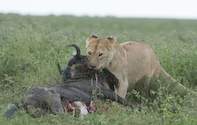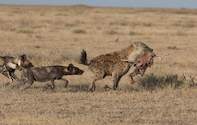
Violent death is not confined to the meek masses, the multitude of grazers. The predators too have to fight for their right to live, to eat and ultimately to breed.
It was Hugo van Lawick and his wife at the time, Jane Goodall, who revealed in their book Silent Killers, that hyenas were more successful hunters than were the lions of the Serengeti. When people saw swollen-bellied cats on a kill in the morning, it was most often a hyena kill the lions had stolen, with the hyena pack waiting nearby to claim back the remains.
The single-minded researcher George Schaller, possibly the· greatest field biologist ever, was the first to study the lion pride of the Serengeti, his work starting in 1966. What be and subsequent researchers found was that male lions lead an often short and always violent life.
As soon as they reach sexual maturity, each day becomes a bank for survival. Competition for breeding rights is continuous, all-out warfare. The victors then set about killing all the offspring of the previous dynasty, They might even kill some of the senior females, which brings the remaining mature females into oestrus and a period of intense mating follows
The deep throaty sounds of male lions roaring are the sounds that humans have feared for aeons, obviously not in our towns and cities, but since the time we slept in caves and suffered the twilight malady known as Hesperian anxiety: the terror of monsters lurking; in the dark.
Schaller's research heir is Professor Craig Packer who joined the Serengeti lion research programme in 1978 and is still there. Quoted by nature writer extraordinaire David Quammen in National Geographic Magazine (August 2013), Packer says: "It's a tough neighbourhood out there. Male coalitions are gangs, if they find a strange male that's hitting on their ladies, they'll kill him."
No animals are by nature evil ( except perhaps some Homo sapiens). But if you want to see violence at its most extreme expression, you will need to follow the lion pride that are living among the greatest concentration of wild animals on our planet.
Serengeti Shall Not Die

The Serengeti represents not only the ultimate wildlife spectacle but is also the manifestation of the great circle of life in two senses. First, it is the migration itself, following the wildebeests' cyclical seasonal journey, a journey with neither beginning nor end, only birth and death to mark the passage. Then it is one of life in its most literal sense: from birth to death, and then through decomposition back into the nutrients that feed the entire system.
In 1957 German-Polish father and son conservationists and filmmakers Bernhard and Michael-Grzimek arrived at the Serengeti to witness and record the great migration, their zebra-striped Dornier aircraft becoming a familiar sight over the plains. Their movie entitled Serengeti Shall Not Die won an Oscar, but sadly Michael collided with a vulture in the air and died before the project had been completed.
Through this and subsequent wildlife films shown in Europe, Bernhard urged people to travel' to this amazing place in order to the wildlife spectacle, believing tourism would ensure its survival He thought nothing of driving his small aquatic car into pods of hippos, or up the churning Nile River below Murchison Falls.
He had inflatable model look-a-likes made of lions, elephants, rhinos and antelopes to see how these animals would react when confronted with a blow-up image of themselves.
He learnt quickly though that wild animal could be unpredictable. On one occasion he approached a black rhino while holding one of his models, and was duly charged by the rhino, which punctured its air-filled adversary and then fled the scene.
As George Schaller observed, when you are opening up a new field of research you grab at anything you can.
You could think of the Serengeti ecosystem as being, the world's most expansive restaurant. Vegetarians are the "regulars": first the wildebeest in their millions, gazelles and zebras in their hundreds, of thousands, buffaloes in their tens of thousands, elephants in their thousands.
This is probably the only game reserve.in Africa where people come to see, primarily, the herbivores rather than the carnivores. When the annual migration is on the move, you can stop just about anywhere on the serengeti (a Maasai word meaning "endless plains") and in every direction the landscape will be a moving mass of animals, dominated by the nasal sounds of the wildebeest that go aaaah, naaah; aaaah; naaah all day and all night long.

 Serengeti National Park Safari Lodges in Tanzania. The Serengeti National Park lies in northwestern Tanzania. See Serengeti National Park sa...
Serengeti National Park Safari Lodges in Tanzania. The Serengeti National Park lies in northwestern Tanzania. See Serengeti National Park sa... The Serengeti is the largest National Park in Tanzania, and one of Africa's premier game parks.The Serengeti plains are the setting for the ...
The Serengeti is the largest National Park in Tanzania, and one of Africa's premier game parks.The Serengeti plains are the setting for the ...